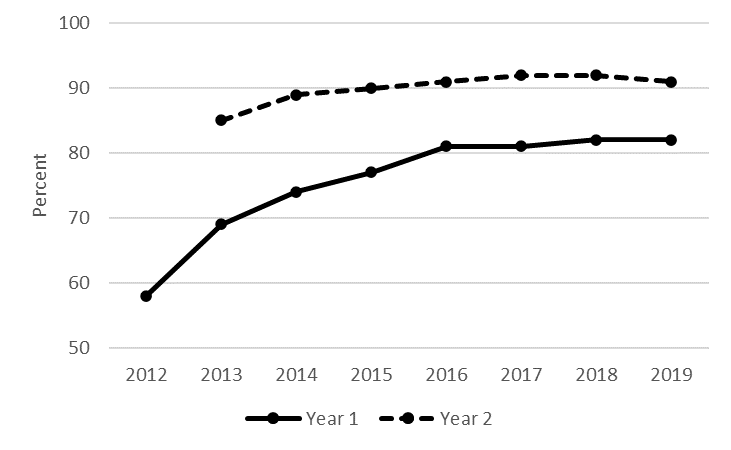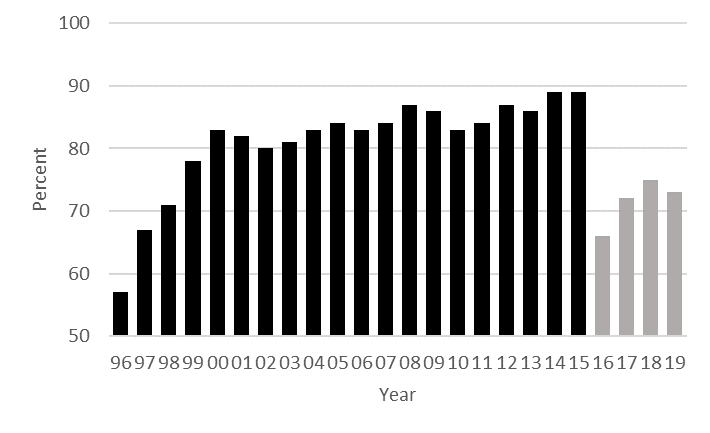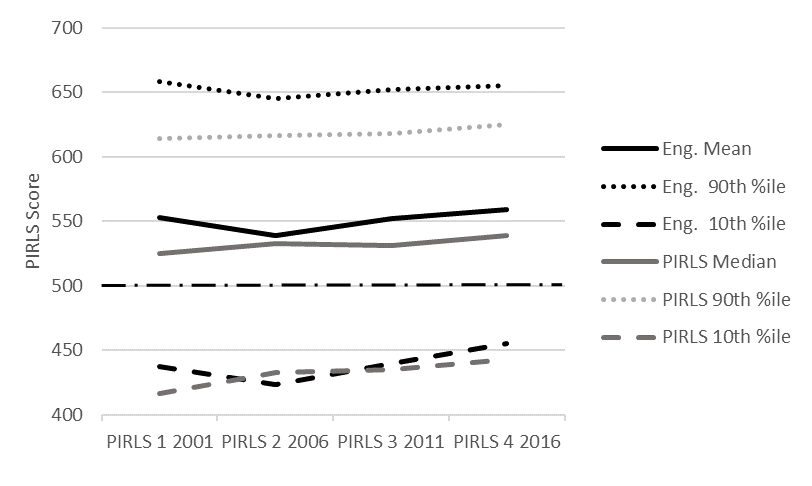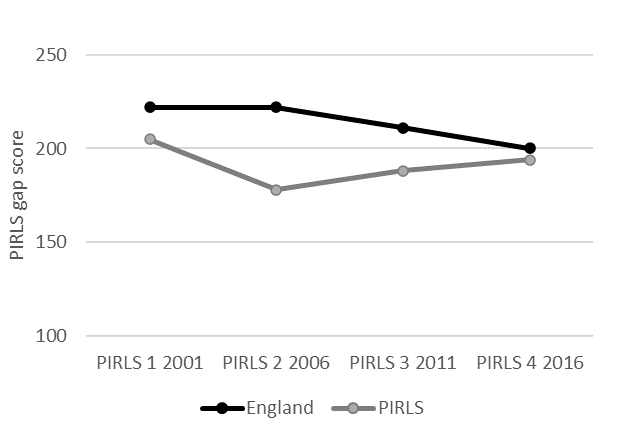
The recent announcement (1) that all NSW public schools will administer the Year 1 Phonics Check (2) 2021 has been widely welcomed (3). The Phonics Check has been administered in South Australian primary schools since 2018. In September this year the federal government launched an online version (4) that is available to all schools, and which has been accessed by over 1000 schools (5) since then.
Not everyone is in favour of the Phonics Check but the most common criticisms of it are easily refutable. An often repeated yet unsubstantiated criticism (6) is that there is no evidence that the Year 1 Phonics Check is associated with improved reading comprehension in later years of school. This claim is demonstrably untrue. In England, where the Phonics Check has been implemented for long enough for it to have had an effect on reading performance, there is growing evidence of improvement.
The graphs below are recreated from a recent peer-reviewed journal article (7) by highly respected reading researcher and educator Professor Rhona Stainthorp, based on official data published by the UK Department for Education.
First, let’s look at performance on the Year 1 Phonics Check itself. In the initial year of the national implementation in England in 2012, 58% of students achieved the threshold score or above. The percentage of children achieving the threshold score increased each year until it stabilised at just above 80% since 2016. Many schools have 100% of students achieving at or above the threshold score but others still have room for growth. An early independent evaluation (8) of the Phonics Check concluded that the assessment had influenced teaching practice in ways that led to better student outcomes in phonic decoding.

Figure 1. Percentage of students achieving the threshold score of 32 or more in the Phonics Check
Second, we can consider performance on other national reading assessments. This picture is a little more complicated because the assessments changed significantly in 2016 with the introduction of a new and more demanding curriculum, and therefore there is a broken trend line. Performance on these tests before and after 2016 cannot be compared – a fact that is often ignored. Nonetheless, there is clear evidence of improvement in both versions of the Key Stage 2 (Year 6) reading tests, which are measures of reading comprehension. It is worth noting that the first cohort of students to perform well in the Phonics Check were in Year 1 in 2016 and will be in Year 6 in 2021, so this is when we would expect to see an impact on KS2 results.

Figure 2. Percentage of students achieving Level 4 or above/Working at expected level in reading in Key Stage 2 tests
Third, there are statistics on Year 4 reading performance from an international assessment called the Progress in Reading Literacy Study (PIRLS) (9). It also measures reading comprehension. In the latest PIRLS, which was conducted in 2016, the average reading score for English students was the highest it has been since the first time England participated in PISA in 2001 (the 2001 results had some sampling differences). Importantly, the attainment gap between the highest and lowest performers narrowed considerably in 2016 at the same time as the average score increased. This means that all students improved, but the lowest performers improved the most.

Figure 3. PIRLS mean scores for England and the PIRLS countries with performance levels at the 10th and 90th centiles

Figure 4. PIRLS attainment gaps between the 90th and 10th centile for England and all participating countries
An analysis published in another peer-reviewed journal article (10) found that a student’s performance on the Year 1 Phonics Check was a good predictor of their performance on PIRLS. That is, students who did well on the Phonics Check in Year 1 were likely to do well on the PIRLS reading assessment in Year 4. Again, it should be noted that the 2016 cohort of PISA students did the Year 1 Phonics Check in only the second year of implementation so we would expect to see a greater average impact in the next cycle of PISA which is due to be conducted in 2021.
The official statistics for the Year 1 Phonics Check (11), Key Stage 2 tests (12), and PIRLS (13) are all readily available online, and the journal articles cited here are available from university library databases or from the authors. When people continue to claim that there is no evidence of impact of the Year 1 Phonics Check without acknowledging these statistics and presenting them accurately, it signals that their objection to it is based on something other than objective analysis.
Another unproven criticism of the Year 1 Phonics Check is that it will inevitably cause teachers to skew their teaching towards phonics at the expense of other aspects of reading. The Year 1 Phonics Check is a one-off, 5-7 minute assessment. The implication that teachers will spend two years teaching toward this single assessment does not put much faith in teachers as professionals. Teachers should and will continue to provide instruction and experiences with other aspects of literacy development and assess them accordingly. It is not an either/or proposition. The Phonics Check is an age-appropriate and valid (14) curriculum-based assessment that provides useful information about phonics decoding at a critical point in children’s reading development.
It is of course true that assessment is not just a one-off ‘event’. Teachers take note of their students’ phonics skills in the classroom each day and use progress monitoring tools, but the Year 1 Phonics Check provides an objective benchmark against which to evaluate formative assessment in the classroom. There are different types of assessment; they do not negate each other. For a teacher who is consistently assessing phonics and decoding with accuracy, the Year 1 Phonics Check will present no challenge whatsoever. Students will achieve well in the assessment if they have had systematic and explicit phonics instruction.
And, finally, there is the assertion that the Year 1 Phonics Check is unnecessary (15) because there is a literacy crisis in secondary schools (16). This argument is self-evidently contradictory. The literacy crisis in secondary school has its roots in primary schools. Almost all of the students who have poor performance in NAPLAN reading tests in Year 7 and 9 have been identified as having poor literacy skills in NAPLAN reading tests in Year 3 and 5. A large proportion of these students have difficulties with reading at the word level that can be improved with phonics instruction (17). Decoding difficulties reduce students’ reading volume and experience, stunting their vocabulary growth and comprehension, and creating a ‘devastating downward spiral’ (18) of low literacy.
Making sure that all students are accurate and fluent word readers in the early years of school, alongside instruction in vocabulary and comprehension as well as spelling and writing, sets children up for literacy success. As described in the Primary Reading Pledge (19), early assessment and intervention including a Phonics Check will eventually reduce the number of students who struggle with reading in secondary school. Again, however, it is not an either/or proposition. Students with reading difficulties at all ages and stages need support.
The introduction of the Year 1 Phonics Check in NSW schools comes after a voluntary trial (20) in 520 NSW schools that found that 43% of students met the expected achievement benchmark. Bearing in mind that the trial took place not long after the COVID lockdown this result is still much lower than ideal. Significantly, though, a survey found that 98% of participating teachers said the assessment provided beneficial information about students’ reading skills. The evaluation of the South Australian trial (21) in 2017 yielded very similar results for students and positive responses from teachers. Since the trial, results have improved each year of the state-wide implementation in South Australia, from 43% achieving the threshold score in 2018, to 52% in 2019, and 63% in 2020.
The Year 1 Phonics Check is a prime example of an evidence-based policy that has been rigorously developed, tested, scrutinised, and evaluated over many years. It has strong research evidence for its technical and theoretical rationale (22) and it has growing evidence of impact in practice. It takes time for changes in early years instruction to take hold and flow through into later years and there are numerous extenuating factors that can mediate the effects, including whether teachers have high quality professional learning and preparation that allows them to respond to the assessment. Nonetheless, there is good reason to believe that the Year 1 Phonics Check is doing what it was designed to do – assess decoding skills and provide guidance for instruction that will improve reading.
Dr Jennifer Buckingham is Director of Strategy and Senior Research Fellow at MultiLit, and also founder and Director of the Five from Five reading project. She chaired the federal government’s advisory group on a Year 1 Literacy and Numeracy Assessment in 2017.
References
- Jordan Baker. Phonics check to be compulsory as minister declares reading wars won. The Sydney Morning Herald, 30 November 2020. https://www.smh.com.au/national/phonics-check-to-be-compulsory-as-minister-declares-reading-wars-won-20201127-p56iol.html
- Jennifer Buckingham. Focus on phonics: Why Australia should adopt the Year 1 Phonics Check. November 2016. MultiLit. https://fivefromfive.com.au/wp-content/uploads/2019/07/Phonics-Check.pdf
- Editorial. We can’t let out children be victims of reading wars any longer. The Sydney Morning Herald, 1 December 2020. https://www.smh.com.au/politics/nsw/we-can-t-let-our-children-be-victims-of-reading-wars-any-longer-20201201-p56jgi.html
Compulsory phonics screening in schools will help close literacy gap. Port News, 3 December 2020. https://www.portnews.com.au/story/7040320/compulsory-phonics-screening-in-schools-will-help-close-literacy-gap/
- Commonwealth of Australia. Year 1 Phonics Check for teachers. Literacy Hub. https://literacyhub.edu.au/phonics-check.html
- Rebecca Urban. Schools get on board for phonics check. The Australian, 8 November 2020. https://www.theaustralian.com.au/nation/schools-get-on-board-for-phonics-check/news-story/19e6410bd39bb9b81e3b75eb23f7249b
- NSW goes full steam ahead with phonics – but does the research support it? The Educator, 7 December 2020. https://www.theeducatoronline.com/k12/news/nsw-goes-full-steam-ahead-with-phonics--but-does-the-research-support-it/274646
- Rhona Stainthorp. A national intervention in teaching phonics: A case study from England. The Educational and Developmental Psychologist, 37(2) 2020, 114-122. doi:10.1017/edp.2020.14
- Matthew Walker et al. Phonics Screening Check evaluation: Final report. June 2015. https://www.nfer.ac.uk/publications/yopc03/yopc03.pdf
- TIMSS and PIRLS International Study Centre. https://timssandpirls.bc.edu/pirls-landing.html
- Kit Double et al. The importance of early phonics improvements for predicting later reading comprehension. British Educational Research Journal, 45(6) 2020, 1220-1234. https://doi.org/10.1002/berj.3559
- UK Department for Education. Statistics: key stage 1. https://www.gov.uk/government/collections/statistics-key-stage-1#phonics-screening-check-and-key-stage-1-assessment
- UK Department for Education. Statistics: key stage 2. https://www.gov.uk/government/collections/statistics-key-stage-2#national-curriculum-assessments-at-key-stage-2
- TIMSS and PIRLS International Study Centre. https://timssandpirls.bc.edu/pirls-landing.html
- Fiona Duff et al. Validity and sensitivity of the phonics screening check: implications for practice. Journal of Research in Reading, 38(2) 2017, 109-123. https://doi.org/10.1111/1467-9817.12029
- NSW goes full steam ahead with phonics – but does the research support it? The Educator, 7 December 2020. https://www.theeducatoronline.com/k12/news/nsw-goes-full-steam-ahead-with-phonics--but-does-the-research-support-it/274646
- Stephen Lamb et al. Educational opportunity in Australia 2020: Who succeeds and who misses out. October 2020. Centre for International Research on Education Systems, Victoria University, for the Mitchell Institute: Melbourne. https://www.vu.edu.au/sites/default/files/educational-opportunity-in-australia-2020.pdf
- Kevin Wheldall et al. (2019). A small group intervention for older primary school-aged low-progress readers: Further evidence for efficacy. The Educational and Developmental Psychologist, 36(2) 2019, 35-40. doi:10.1017/edp.2019.15
- Joseph K. Torgesen. Avoiding the devastating downward spiral: The evidence that early intervention prevents reading failure. American Educator, Fall 2004. https://www.aft.org/periodical/american-educator/fall-2004/avoiding-devastating-downward-spiral
- Five from Five, AUSPELD, Learning Difficulties Australia. Primary Reading Pledge: A plan to have all children reading by the end of primary school. August 2020. MultiLit. https://fivefromfive.com.au/primary-reading-pledge/
- NSW Department of Education. Phonics Screening Check. https://www.cese.nsw.gov.au/images/stories/PDF/Phonics-Screening-Check-AA.pdf
- Ann-Louise Hordacre et al. Evaluation of the trial of the UK Phonics Screening Check in South Australian schools. December 2017. Flinders University. https://www.education.sa.gov.au/sites/default/files/evaluation-uk-phonics-screening-check-sa.pdf?acsf_files_redirect
- Rhona Stainthorp. A national intervention in teaching phonics: A case study from England. The Educational and Developmental Psychologist, 37(2) 2020, 114-122. doi:10.1017/edp.2020.14
UK Standards and Testing Agency. Year 1 Phonics Screening Check: Pilot 2011 Technical Report. 2012. https://assets.publishing.service.gov.uk/government/uploads/system/uploads/attachment_data/file/368290/phonics_2011_technical_report.pdf
Jennifer Buckingham et al. National Year 1 Literacy and Numeracy Assessment: Expert advisory panel advice to the minister. April 2017. https://docs.education.gov.au/system/files/doc/other/panel_advice_web_accessible_version_cover_change.pdf


